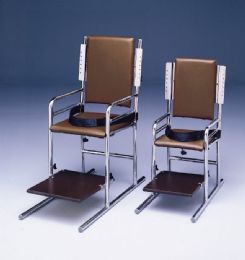
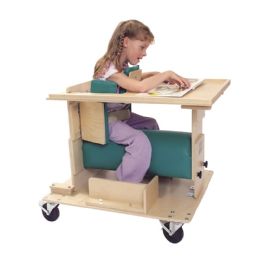
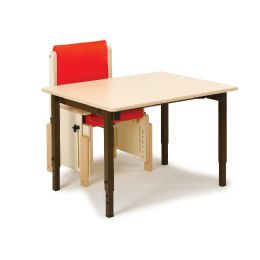
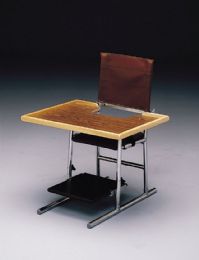
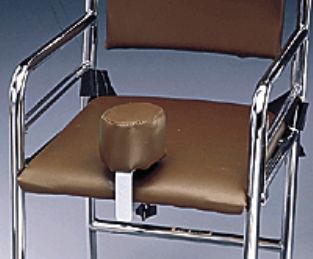
What is a Bolster Chair?
A bolster chair is helpful for athetoid or spastic children who need hip flexion with abduction to achieve their best trunk and pelvic alignment for sitting. This posture helps bring the hands and arms forward for function. It also helps decrease knee and hip extension, promotes a more vertical pelvis, and provides alignment for normal spinal curves. In addition, by adding a firm back, lateral pelvic supports and foot supports, the seat promotes symmetry and alignment without the need for discouraging restraints. A bolster chair is an excellent seating alternative for children who normally sit with the legs underneath in a “W” position. Prolonged sitting in this position may lead to adduction and internal rotation of the hips, and may limit a child’s ability to move into and out of sitting. A bolster chair maintains hip abduction and flexion with external rotation, a position that helps with movement in sitting.
How Do I Choose the Best Table and Chair for My Child, Client or Student?
There are many factors to consider when choosing chairs for children, including comfort and quality. Choose designs that will be comfortable as well as sturdy, well made chairs that will stand up to lots of use. Another consideration is the style of the chair, since there are a variety of different types, such as rockers, recliners, and bean bags. It may be helpful to have the kids help choose the chairs so they will use and enjoy them. It might also be a good idea to select models that work well with the existing décor if the chairs will be in a common area of the home or facility.
Quality is one of the most important factors to consider when choosing the best chair for children. A chair meant to be used by youngsters should be built to survive a certain amount of abuse. It is important that the chairs are well put together and sturdy so that they do not break and possibly injure a child in the process. Also, look for durable materials such as solid wood and heavy plastics. If the chairs are upholstered, select thick, strong fabrics made for furniture and, if available, add stain protection.
Comfort is another key element in the chair selection process, as this ensures the child will continue to use the chair. The more comfortable the chairs are, the more likely the children will use them for their intended purposes. This is especially important if a particular chair is meant for activities such as reading and homework. If this type is uncomfortable, it can be a big distraction.
Because of the vast assortment of styles available in pediatric tables and chairs, it is important to determine the intended usage for this furniture to make the most appropriate selection. Some designs are just for fun and comfort, such as saucer chairs and bean bags. Others resemble scaled-down versions of adult chairs, including armchairs, recliners, and rockers. There are tables and chairs specifically designed for use in the classroom or a study room at home, while other styles are well suited for therapy or care facilities. Tables and chairs for children can be used in a variety of ways at home, such as in the bedroom, playroom, or common living area.
Rehabmart is pleased to carry a wide variety of fun and functional pediatric tables and chairs for all types of children from high quality vendors, such as Hausmann Industries, Freedom Concepts, Sammons Preston, R.E.A.L Design, SportPlay Equipment, Southpaw Enterprises, Kaye Products Inc., Drive Medical, Bailey Manufacturing Company, and Otto Bock Health.
Mike Price, OT
Rehabmart Co-Founder & CTO